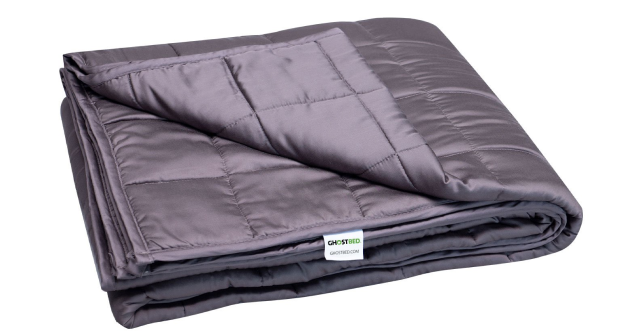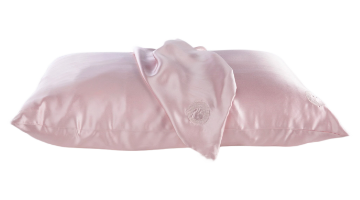The early bird gets the worm, but what if you don’t drift off until after the other birds are asleep? As a chronic night owl, it’s a problem I’ve always had.
When I started working as the Content Lead here at GhostBed, the question became more pressing. After all, if I’m spending my entire day writing about sleep, shouldn’t I get to bed at a reasonable time?
I set out to discover if it was possible for someone like me–who is often wide awake and happiest in the hours after midnight–could go to sleep consistently by 10 pm.

Why It’s a Good Idea to Go to Bed Early(ish)
Despite my tendency to hit the sack late, I’ve always been a functioning member of society. If my day starts a little later, it ends later too. So I’m generally as productive as my early-rising counterparts.
I get enough sleep most nights. Plus, I live alone. So I’m not keeping anyone up doing pilates at midnight. Unless I have an early-morning obligation, the late-night thing works pretty well for me. So do I really need to fall asleep earlier?
According to science, the answer may be yes. Going to bed at a reasonable time (think 9 pm to 11 pm) can help support the delicate balance of hormones–like cortisol and melatonin–that regulate sleep, alertness and stress.
Plus, it helps your body get the right exposure to natural light throughout the day, which has a host of benefits.
And of course, if your job, children or other obligations require you to be up in the wee hours of the morning, getting to bed early is critical to getting enough shut-eye.

But What About Chronotypes?
If you, like me, feel averse to an early bedtime, your chronotype may be to blame.
This buzzy term is used to categorize the peak periods of sleepiness and alertness folks experience throughout the day.
There are three chronotypes:
- The morning/lark chronotype who feels the most energetic and awake early in the morning. Larks are lucky birds indeed, as their natural rhythm jibes with most work and school schedules.
- The intermediate/hummingbird chronotype, who typically experiences peak alertness around noon. They’re the goldilocks of sleepers, going to bed not-too-late and not-too-early.
- The evening/owl chronotype, who is most energized and focused in the evening and nighttime. The owl struggles to wake up early and–surprisingly–is relatively rare. It’s estimated only 15 percent of the population fits into this chronotype. I certainly am one of them.
Once I learned I was an owl chronotype, I felt justified in my nocturnal behavior. Surely if my body’s natural rhythm is to stay up late, it doesn’t make sense to go to bed earlier. Right?
Sort of. The reality is health is personal, and what works for one person may not work for the next. So if studies say a 9 pm bedtime is best, but you can’t fall asleep before midnight, it may truly be most “natural” for you to tuck in later.
That said, moderation is our friend here. Just like someone with a sweet tooth doesn’t have a pass to eat endless cookies, a natural night owl needn’t stay up until sunrise. Opting for a healthy middle-of-the-road bedtime is likely your best bet.
Consider What’s Keeping You Up
A Google search for “how to fall asleep earlier” yields an impressive list of mistakes I may be making in my journey toward an earlier bedtime.
I chose three areas I knew I could improve on and held myself accountable.
Blue Light Exposure
Most of us know by now that the blue light from our phones, computers and TV screens is doing us no favors when it comes to quality sleep. Most experts recommend shutting them off at least an hour before bedtime.
I have a pretty consistent before-bed reading routine, so I thought I was doing fine here.
But once I brought awareness to my screen habits, I realized how often I was grabbing my phone when I was already tucked into bed. Once to text my boyfriend goodnight, again to check the weather, and a third time to look up something that popped into my mind–it added up quickly.
The solutions were simple here. I bid my loved ones goodnight before I got into bed and kept a notepad by my bed to document anything I wanted to look up in the morning.

Too Much Caffeine
After drinking cold brew like water through my teens and twenties, I suddenly stopped tolerating caffeine. Some days I’ll allow myself a green tea or matcha–and if I do I know I’ll be up later than ever–but mostly I stay away from the stuff.
If you find yourself struggling to tuck in early, your coffee cup is the first place you should look. Most experts recommend having your last cup six hours before bedtime.
The general consensus is that up to four 8-ounce cups of coffee before that time won’t interfere with sleep. But listen to your body.
For my experiment, I put a temporary hiatus on all caffeine (even the innocent-seeming green tea) and kept a tally on my whiteboard to document my days without it. As the days added up, my sleep improved too.
An Uncomfortable Sleep Setup
Especially as we get older, the wrong mattress or pillow can make a big difference in our ability to fall asleep. While my mattress has felt fine, I’ve never felt supported by my pillow as a side sleeper.
It just so happens that I work for a company who makes the best pillows, so I asked them to send one my way. I went with the gel memory foam pillow and had zero regrets.
The pillow’s thick loft filled in that awkward space that forms between my head, neck and the bed when I lie on the side–eliminating my uncomfortable muscle strain.
I didn’t realize how many precious minutes I’d spent stacking and rearranging pillows before sleep until I didn’t have to do it anymore.
Plus this pillow is tangibly cool to the touch, which creates a nice tactile distraction from my busy thoughts as I try to drift off.

Use Light to Your Advantage
With some of the biggest obstacles to good sleep tamed, I started to see improvements in my bedtime. But I wanted to know if I could do better.
There’s a lot of buzz about using light to benefit your health these days–whether it’s using a sunrise alarm clock to wake up gently or a red light to purportedly cure all your ills.
I decided to keep it simple by assigning myself two tasks: get sunlight first thing in the morning and keep the lights low in my apartment before bed.
Using Morning Sunlight
We have a great article on using sunlight to help you sleep. The gist is that it helps regulate your internal clock.
When you get sun in your eyes and on your skin first thing in the morning, your body has a better understanding of what time it is, which means it’ll also know when it’s time to tuck in in the evening.
I wake up starving, so while I couldn’t swing a sunlight walk the second I woke up, I did it right after breakfast.
I noticed a difference in my mood right away, and I did start to feel more sensitive to the sun setting at the end of the day, leading me to cozy up and get into bedtime mode sooner.
Keeping Lights Low in the Evening
Just like staring at a bright phone before bed can be overstimulating, so too can bright overhead lights.
I’m already a fan of ambient lighting and candles, so I rarely have the overhead lights on to begin with. But I realized I was still showering in a brightly-lit bathroom immediately before tucking into bed.
I switched to candles by the shower while I lathered up and noticed a huge difference. Between the warm water and low lighting, my eyelids began feeling heavy before I even dried off.

The Results
There are countless changes you can make to help you fall asleep earlier, but the truth is you probably only need to do a few of them.
In fact, trying to change too many things at once is likely to have the opposite effect–throwing off your routine and your sleep in the process.
For me, implementing a few changes like being mindful about light, using quality bedding and taking a caffeine hiatus really did help. I’ve been getting to bed most nights between 10 pm and 11 pm, which is a far cry from the 2 am I’m used to.
I know that over time, I’ll likely drift toward a later schedule. But I always have these tools to bring me back to a reasonable time.
If you’re trying to hit the hay a little earlier and think better quality bedding might help, can I suggest starting with finding the right mattress for you? It may be all you need for those early mornings to feel a little less painful.





